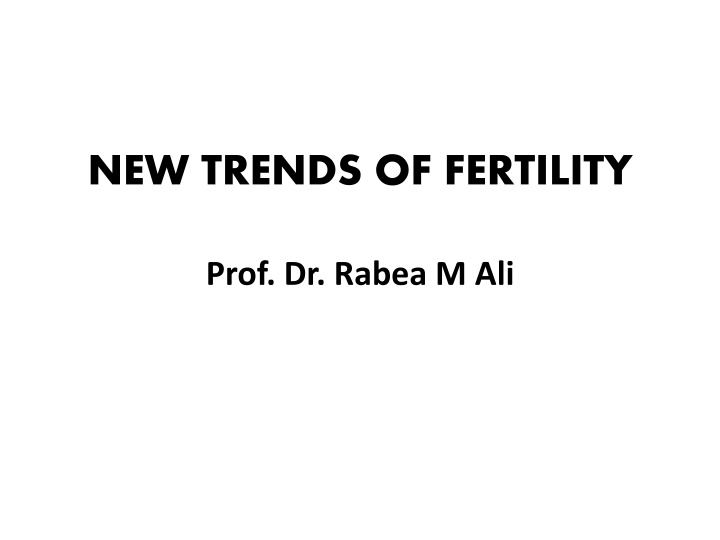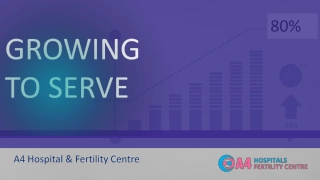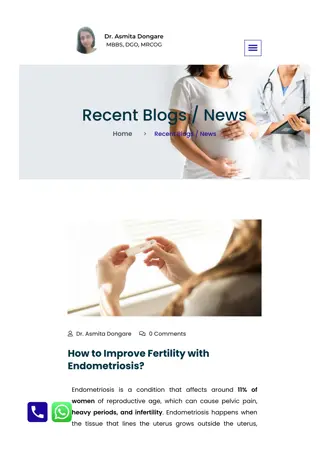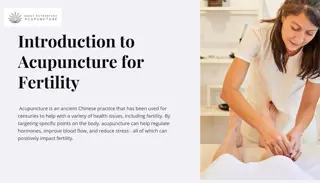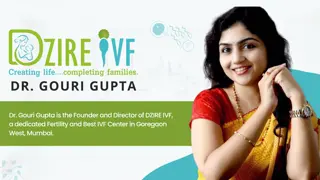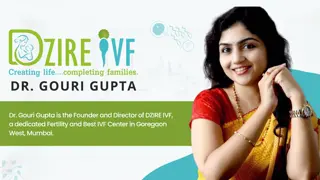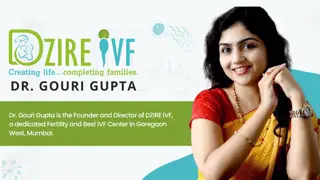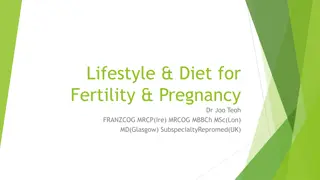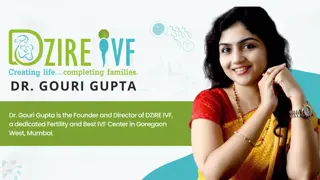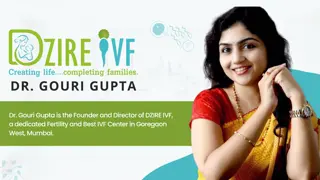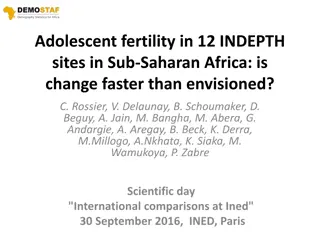NEW TRENDS OF FERTILITY
Fertility issues can be a profound crisis for couples, with primary and secondary infertility posing unique challenges. Factors influencing fertility services include education, awareness, and access to care. Evaluating infertility involves multiple components. Treatment goals prioritize patient safety and successful family building. Options range from ovulation induction to assisted reproductive technologies. Clomiphene citrate is a common first-line therapy, with good success rates. Stay informed about the latest trends in fertility to make well-informed decisions for your reproductive health.
Download Presentation

Please find below an Image/Link to download the presentation.
The content on the website is provided AS IS for your information and personal use only. It may not be sold, licensed, or shared on other websites without obtaining consent from the author.If you encounter any issues during the download, it is possible that the publisher has removed the file from their server.
You are allowed to download the files provided on this website for personal or commercial use, subject to the condition that they are used lawfully. All files are the property of their respective owners.
The content on the website is provided AS IS for your information and personal use only. It may not be sold, licensed, or shared on other websites without obtaining consent from the author.
E N D
Presentation Transcript
NEW TRENDS OF FERTILITY Prof. Dr. Rabea M Ali
INFERTILITY The inability to create a desired pregnancy that culminates in the birth of a child is likely to create a life crisis for women and their partners. Women seeking fertility treatment look to nurses for care, counsel and health teaching.
Primary infertility: The inability to conceive after 1 year of unprotected intercourse for a woman younger than 35, or after 6 months of unprotected intercourse for a woman 35 or older. Secondary infertility: The inability of a woman to conceive who previously was able to do so .
Factors Influencing the Use of Fertility Services - Increased education and career opportunities for women - Increased number of providers and centers offering fertility services - Increased public awareness of infertility and treatment options
Evaluation of the Woman Primary evaluation components: Male factor Ovarian factor Cervical factor Tubal factor Uterine factor
Infertility Treatment: Goals To ensure patient safety To help a couple experience a healthy pregnancy and birth or an alternative way to build a family To use as little of a couple s resources as necessary
Infertility Treatment: Options Correct ovulatory dysfunction Correct tubal or uterine abnormalities Overcome sub fertile sperm parameters ART
Ovulation Induction: Clomiphene Citrate (Clomid, Serophene) The first line of fertility therapy Used to treat mildly disordered ovulation and luteal- phase insufficiency Establish tubal patency and sperm adequacy before use. In appropriately selected patients, 80 percent ovulate and 40 percent conceive with clomiphene. Cumulative conception rate is 60 percent to 75 percent Multiples rate is about 10 percent After 6 months, women should move on to more aggressive therapy.
Ovulation Induction: Injectable Gonadotropins Used: When women exhibit resistance to clomiphene When multiple oocytes are desirable to ovulate With IVF and creation of donor oocytes and embryos With ovulation induction (OI) Multiple rates as high as 40 percent.
Ovulation Induction: Pulsatile Gonadotropin-Releasing Hormone Anovulation may be due to the failure of the hypothalamus to provide sufficient stimulation to the pituitary gland. Gonadotropin-releasing hormone (GnRH) can be directly administered via a small medication pump to induce ovulation. The ideal patient is the hypo-gonadotropic woman.
Dehydro- Epiandro- Sterone (DHEA) Also known as Androstenelone is an endogenous steroid hormone produced by adrenal glands in the brain, it functions as metabolic intermediate in the biosynthesis of androgen and estrogen sex steroids both in the gonads and ovaries and in other various tissues so replaces this hormone with in the body. INOSITOL Dose 2-4 G Improves several of the hormonal disturbance of PCOS
Artificial Insemination Used to treat: Male-factor infertility Retrograde ejaculation Neurologic impotence Sexual dysfunction Sperm used for insemination may be the male partner s or donated.
Artificial Insemination Methods of insemination Intra-cervical insemination (ICI) Intrauterine insemination (IUI) Success rates vary from 6 percent to 24 percent per cycle
Assisted Reproduction Indications for ART: Tubal disease Male-factor infertility Endometriosis Premature ovarian failure Polycystic ovarian syndrome Immunologic infertility Unexplained infertility
Assisted Reproduction IVF: Placing the gametes and subsequent embryo into the uterus ZIFT (zygote intra-fallopian transfer): Placing the gametes and subsequent embryo into the fallopian tubes GIFT (gamete intra fallopian transfer): Placing the unfertilized oocyte and sperm into the fallopian tube
Assisted Reproduction Stimulation type, dosage and duration depends on patient characteristics, diagnoses and the fertility center. Monitoring is usually by serial TVUS, usually over four to five visits.
Assisted Reproduction Cleavage of the embryos and other subjective indicators of embryo health help the clinician decide timing and number of embryos to transfer. The usual timing of transfer of embryos is on day 3, 4 or 5 after retrieval.
Assisted Reproduction Multicellular embryos
Assisted Reproduction: Cryopreservation Freezing, thawing and using: Sperm Embryos Oocytes
Cryopreservation :is the proses that preserve organelles, cells, tissues or any other biological constructs by cooling the samples to very low temperatures Embryo cryopreservation used to storage embryonic IVF Ovarian tissue cryopreservation or women in case of hematological malignancies or ca Breast
Oocyte cryopreservation :where t he women's eggs(oocyte) are extracted ,frozen, and stored later when she is ready to become pregnant the eggs can be thawed, fertilized ,and transferred to the uterus Semen cryopreservation :used in case of treatment that compromised their fertility such as chemotherapy or radiation or surgery
Assisted Reproduction: Cryopreservation Expanded blastocysts
Assisted Reproduction: Cryopreservation Cryopreserved blastocysts
Pre-implantation Genetic Diagnosis (PGD) Used only with IVF One or two cells removed from the embryo and analyzed for defects before transfer to the uterus
PGD (Continued) May be helpful for: Women older than 35 years Couples who have experienced recurrent pregnancy loss Couples with one partner known to carry a balanced chromosomal translocation Up to 85 percent accurate for detecting the most common chromosomal abnormalities
Third-party Reproduction Donor : Sperm ( by intrauterine insemination (IUI) or intra-cervical insemination, ICI form donor either from sperm bank or known donor. Donor EGG( an ovum is taken from donor ). Surrogacy :women with no egg or un healthy eggs might also want to consider surrogacy is a women who agree to become pregnant using mans sperm and her own egg. Gestational carrier: Carries other people s oocyte and sperm(NOT BIOLOGICAL MOTHER ) Traditional surrogate: Inseminated with the male partner s sperm(BIOLOGICAL MOTHER)
Third-party Reproduction (Continued) Fertilized oocyte
ART Risks and Complications Ovarian hyper stimulation syndrome (OHHS) Multiple gestation: More than 43 percent of the rise in multiple births is linked to ART, with 25 percent to 38 percent of treatments leading to multiple births
ART Risks and Complications (Continued) Twin intrauterine pregnancy
Male-factor Infertility ART may help men with: Sperm counts between 1 and 10 million with poor motility and morphology scores Failed previous inseminations Obstructive or non obstructive azoo-spermia where sperm can be successfully extracted from the epididymis or testes
Male-factor Infertility (Continued) Intracyto-plasmic sperm injection (ICSI)
Advanced Reproductive Age Risks Pregnancy loss at all stages of gestation Down syndrome Multiple births Hypertension and gestational diabetes Low birth weight (LBW) Difficult labor Cesarean birth Risks associated with older childbearing are manageable. Most women can expect positive outcomes. Nurses should counsel women in their early 30s about fertility.
Using acupuncture for fertility Acupuncture used to boost their fertility thus improve intrauterine blood circulation ,regular ovulation and increase sperm count Low level laser therapy (LLLT):used to treat in case of advanced maternal age and poor ovarian function . Solography :help to direct visualization to diagnoses infertility. Hysteroscopy :also direct visualization to pelvic and uterus and ovaries
Special Role of Nursing To help reduce a woman s anxiety, increase her knowledge and validate the significance of her experience throughout evaluation and treatment To guide the woman through grief that follows unsuccessful treatment and help her determine when it is time to stop treatment Giving anticipatory guidance Providing a quiet, private place for consultation Allowing adequate time for questions and discussion
Giving patient-specific instructions Giving therapeutic touch, when appropriate Maintaining personal contact during and after treatment cycles Recognizing the need for grief work Expressing positive and negative feelings Providing easy access to nursing care Follow up to discuss options and emotional status
